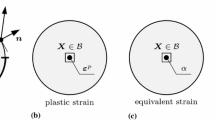Two types of constitutive equations accounting for the stress mode and the loosening of the material during elastoplastic deformation are considered. The constitutive equations of one type include two nonlinear relationships between the first invariants of the stress and strain tensors and between the second invariants of the deviator tensors and include the third invariant of the stress deviator. The constitutive equations of the other type use equivalence stress containing the first and second invariants of the stress tensor. Literature experimental data for tubular isotropic specimens under tension, compression, torsion, and internal pressure are used for assessing the loosening of the material.
Similar content being viewed by others
References
V. M. Volkov, “Loosening of metals and fracture of structures of machines,” Nauch. Probl. Vodn. Transp., VGAVT, Nadezhn. Resurs, No. 4, 50–68 (2003).
A. A. Zolochevskii, “Modification of the theory of plasticity of materials differently resistant to tension and compression for simple loading processes,” Int. Appl. Mech., 24, No. 12, 1212–1217 (1988).
A. A. Zolochevskii, A. N. Sklepus, and S. N. Sklepus, Nonlinear Solid Mechanics [in Russian], Business Investor Group, Kharkiv (2011).
L. M. Kachanov, Fundamentals of the Theory of Plasticity, Dover, New York (2004).
N. N. Malinin, Applied Theory of Plasticity and Creep [in Russian], Mashinostroenie, Moscow (1975).
A. Nadai, Theory of Flow and Fracture of Solids, McGraw Hill, New York (1950).
V. V. Novozhilov, “On plastic cavitation,” J. App. Math. Mech., 29, No. 4, 811–819 (1965).
V. A. Panyaev, On Deformation and Fracture of Semibrittle Bodies [in Russian], Author’s Abstract of PhD Thesis, Frunze (1970).
Yu. N. Rabotnov, Solid Mechanics [in Russian], Nauka, Moscow (1979).
O. G. Rybakina and I. S. Sidorin, “Experimental studies of the laws of plastic loosening of metals,” MTT, No. 1, 120–124 (1966).
Yu. N. Shevchenko, M. E. Babeshko, and R. G. Terekhov, Thermoviscoelastoplastic Processes of Combined Deformation of Structural Members [in Russian], Naukova Dumka, Kyiv (1992).
M. E. Babeshko and V. G. Savchenko, “Analyzing processes of nonisothermal loading of shells of revolution with allowance for repeated plastic strain,” Int. Appl. Mech., 53, No. 6, 639–646 (2017).
M. E. Babeshko and V. G. Savchenko, “Allowing for the third deviatoric stress invariant in analyzing the deformation of thin shells,” Int. Appl. Mech., 54, No. 2, 163–171 (2018).
M. E. Babeshko and V. G. Savchenko, “Method of solving the problem of thermoradiation plasticity for layered axisymmetric bodies made of isotropic and orthotropic materials,” Int. Appl. Mech., 57, No. 3, 306–319 (2021).
M. O. Babeshko and V. G. Savchenko, “Elastoplastic axisymmetric stress–strain state of thin shells made of materials with different compressive and tensile moduli,” Int. Appl. Mech., 57, No. 4, 414–423 (2021).
M. E. Babeshko and Yu. N. Shevchenko, “Method of successive approximations for solving boundary-value problems of plasticity with allowance for the stress mode,” Int. Appl. Mech., 46, No. 7, 744–752 (2010).
M. E. Babeshko, Yu. N. Shevchenko, and N. N. Tormakhov, “Constitutive equations of elastoplastic isotropic materials that allow for the stress mode,” Int. Appl. Mech., 45, No. 11, 1189–1195 (2009).
M. E. Babeshko, Yu. N. Shevchenko, and N. N. Tormakhov, “Approximate description of the inelastic deformation of an isotropic material with allowance for the stress mode,” Int. Appl. Mech., 46, No. 2, 139–148 (2010).
M. E. Babeshko, Yu. N. Shevchenko, and N. N. Tormakhov, “Applicability of the constitutive equations incorporating the third deviatoric stress invariant to the description of the nonlinear deformation of coarse-grained metal,” Int. Appl. Mech., 51, No. 4, 403–407 (2015).
J. J. Guest, “On the strength of ductile materials under combined stresses,” Philos. Magaz. J. Sci., 50, No. 302, 69–132 (1900).
R. Hill, The Mathematical Theory of Plasticity, Claredon Press, Oxford (1950).
W. Lode, “Versuche über den Einfluss der mittleren Hauptspannung auf das Fliessen der Metals—Eisen, Kupfer und Nickel,” Z. Physik, 36, 913–939 (1926).
L. Prandtl, “Spannungsverteilung in plastischen Körpern,” in: Proc. 1st Int. Congr. Appl. Mech., Delft (1924), pp. 43–54.
V. G. Savchenko, “A method to study the nonaxisymmetric plastic deformation of solids of revolution with allowance for the stress mode,” Int. Appl. Mech., 44, No. 9, 975–981 (2008).
Yu. N. Shevchenko and V. G. Savchenko, “Three-dimensional problems of thermoviscoplasticity: Focus on Ukrainian research (review),” Int. Appl. Mech., 52, No. 3, 217–271 (2016).
Yu. N. Shevchenko, R. G. Terekhov, and N. N. Tormakhov, “Constitutive equations for describing the elastoplastic deformation of elements of a body along small-curvature paths in view of the stress mode,” Int. Appl. Mech., 42, No. 4, 421–430 (2006).
Yu. N. Shevchenko, R. G. Terekhov, and N. N. Tormakhov, “Linear relationship between the first invariants of the stress and strain tensors in theories of plasticity with strain hardening,” Int. Appl. Mech., 43, No. 3, 291–302 (2007).
Yu. N. Shevchenko, R. G. Terekhov, and N. N. Tormakhov, “Elastoplastic deformation of elements of an isotropic solid along paths of small curvature: Constitutive equations incorporating the stress mode,” Int. Appl. Mech., 43, No. 6, 621–630 (2007).
F. Schleicher, “Der Spannungszustand an der Fliesgrenze,” ZAMM, 6, No. 3, 199–216 (1926).
P. A. Steblyanko and Yu. N. Shevchenko, “Computational methods in stationary and nonstationary thermal—Plasticity problems,” in: R. B. Hetnarski (ed.), Encyclopedia of Thermal Stresses, Vol. 2, C-D, Springer, New York–Dordrecht (2014), pp. 623–630.
M. Zyczkowski, Combined Loadings in the Theory of Plasticity, Panstwowe Wydawnictwo ‘Naukowe–Polish Scientific Publishers, Warszawa (1981).
Author information
Authors and Affiliations
Corresponding author
Additional information
Translated from Prykladna Mekhanika, Vol. 58, No. 3, pp. 50–58, May–June 2022.
* This study was sponsored by the budgetary program Support of Priority Areas of Research (KPKVK 6541230).
Rights and permissions
Springer Nature or its licensor (e.g. a society or other partner) holds exclusive rights to this article under a publishing agreement with the author(s) or other rightsholder(s); author self-archiving of the accepted manuscript version of this article is solely governed by the terms of such publishing agreement and applicable law.
About this article
Cite this article
Babeshko, M.O., Savchenko, V.G. Different Options of Accounting for Loosening in the Theory of Isotropic Plasticity*. Int Appl Mech 58, 289–298 (2022). https://doi.org/10.1007/s10778-022-01154-1
Received:
Published:
Issue Date:
DOI: https://doi.org/10.1007/s10778-022-01154-1



